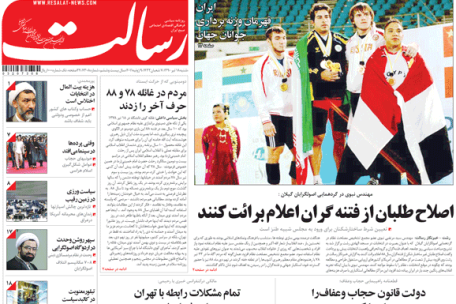The Domino That Didn’t Pan Out

July 9th is the reminder of the breakout of the Kuy-e Daneshgah incident, during the second year of Reformist Mohammad Khatami’s presidency. What started as an angry but limited student protest evolved into 4 days of chaos across Tehran, ultimately dying down after a march by IRI-loyal groups on July 14th 1999. The conservative Resalat newspaper has run a historical account of the development on its 12th anniversary:
The Kuy-e Daneshgah (1) fray of July 9, 1999 was a part of the subversion domino leveled at the Islamic Republic, one which evolved into a more complicated pattern ten years later during the ’88 Fetneh [2009 post-presidential election unrest]. However, the insight of the Iranian nation, under the astute leadership of Ayatollah Khamenei, stamped it out permanently. The brawl was the product of 10-year planning by the enemies of the Islamic Revolution for an actual confrontation with the Revolution after the demise of Emam Khomeini.
On the 22nd anniversary of His Excellency Emam Khomeini’s demise, the Supreme Leader of the Islamic Republic addressed this issue: “in ’78 [1999] those who neutralized these incidents were the people. They came into the streets on 23rd of Tir [July 14th] and put an end to the plot taking the enemy years to contrive, in one day...the second wave was again a ten-year planning until ’88 [2009]. They thought they had prepared the ground… people meanwhile had demands –people who were [nevertheless] faithful to the Revolution- which they thought they can exploit...but after their true nature was revealed our dear nation came to the streets and ended the dispute.”
The Kuy-e Daneshgah saga started with the Americans’ green light, with the excuse of the Reformists’ and their affiliated media opposing amendments to the Press Law made by the Fifth parliament and [the ensuing] shutdown of Salam newspaper. In summer of 1999, the Fifth Parliament’s Cultural Committee passed a bill titled “Press Law Amendment”, which was opposed by the Reformists. The [Reformist] Association of Combatant Clerics released a statement calling the amendment “restrictive and spreading the shadow of dictatorship over the press terrain.” One day before the bill was to be ratified, [the Reformist] Salam newspaper published a confidential document attributing the original plan to Saeed Emami (2). A lawsuit filed by the Ministry of Intelligence and some MPs brought Salam closure until further notice. In the wake of the closure, the Reformist media set off on revenge talk against the Islamic Nezam with biting language: “Press limits inflames people’s rage”, “time is pregnant with violent incidents”, “students won’t remain silent”, “the end of politics”, etc., to portray a restive atmosphere.
Following the breakout of a tussle in Kuy-e Daneshgah on the dawn of Tir 18, 1378 -directed by the eminence grise behind the curtains- on the excuse of suspicious elements dubbed ‘the plain clothes’ attacking the Kuy, certain groups mounted the stage. As the protests spread, Mojahedin-e Khalgh, monarchists and the alliance of counter-revolutionary forces came to the fore under the guise of students and ordinary citizens. Evidence proved that more than being a spontaneous social move by the students, the Kuy-e Daneshgah contention was a resort by radical Reformist groups, supported by the ministries of interior and higher education, to advance their own interests based on Saeed Hajjarian’s (3) theory of “pressure from below, bargain at the top”.
On 21st of Tir 1999, in meeting with students, Ayatollah Khamenei warned about the enemy’s exploitation of the situation and chastised political groups for giving the enemy a chance to “sting”. The next day, the Supreme Leadership sent Iranians a message calling them to “step on the stage” as “thugs along with bankrupt political groups encouraged and supported by foreign enemies have started sabotage…across Tehran. Pitiful enemies of Islam and the Revolution have thought that our devoted, revolutionary people will allow them… to pave the way for domination of the felonious Untied States…they are ignorant that our brave people…won’t permit them to continue villainy and the powerful Islamic Nezam will firmly suppress them.” The message led to a massive rally of 23rd of Khordad in support of Velayat-e Faqih and condemnation of agitators. Unprecedented participation of people following the call of the Supreme Leadership displayed the power and influence of the Islamic Republic among the public for the domestic and expatriate opposition. After this massive rally, the Kuy-e Daneshgah fight effectively ended
(1) Kuy-e Daneshgah is the main dormitory of Tehran University students, located in central Tehran. The settlement, which hosts about 8 thousands students, is known for its fervent political atmosphere and has played a central role in several cases of political unrest since the Reform era.

